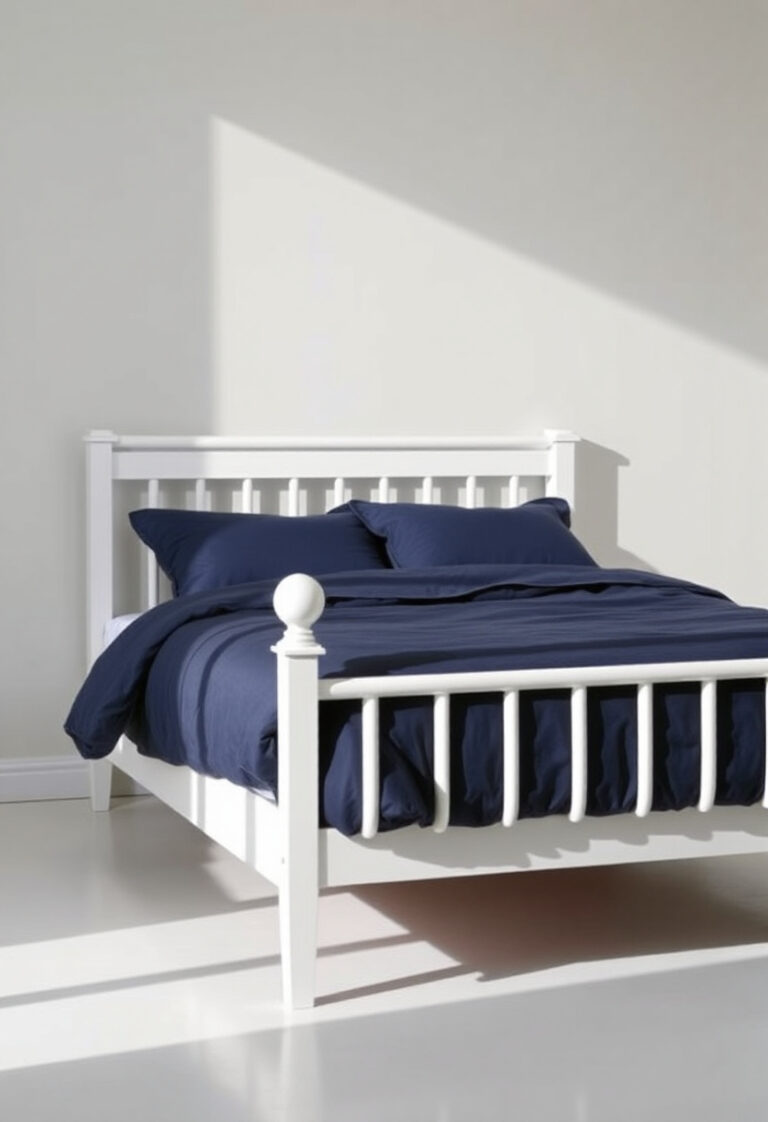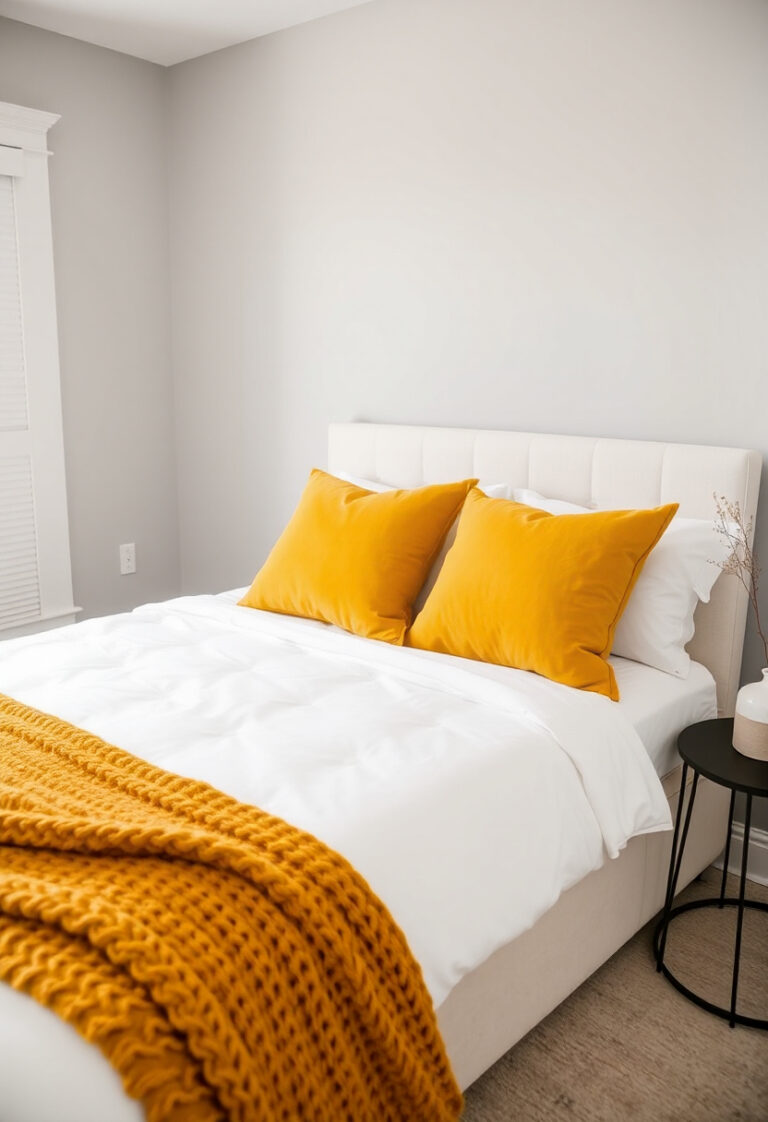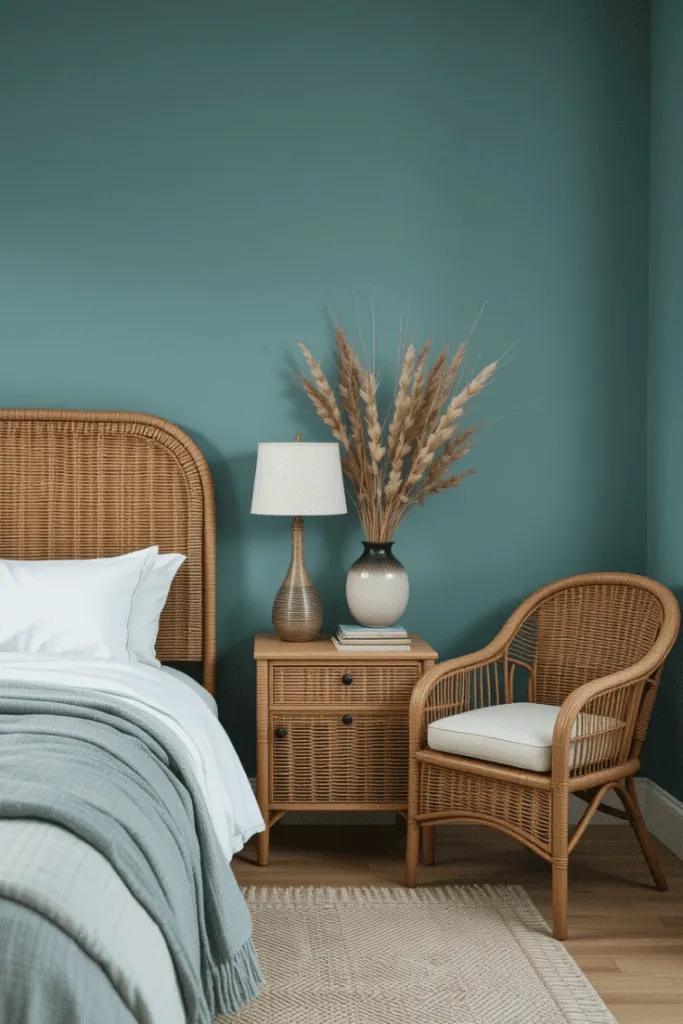Designing a white and gray bedroom offers a clean, modern approach that emphasizes balance and refinement. This neutral palette supports a wide range of design styles—from contemporary to transitional—while establishing a calm, uncluttered atmosphere. The following ideas highlight how thoughtful use of these tones can shape a space that feels composed, cohesive, and visually appealing.
The Appeal of White and Gray Bedrooms
White and gray bedrooms offer exceptional versatility as a foundation for nearly any decorating style. This neutral combination provides balance—white brings brightness and spaciousness while gray adds depth and dimension. Together, they create an environment that feels both fresh and grounded, making your bedroom a restful respite from the outside world.
20 White and Gray Bedroom Design Ideas
1. Layered Bedding in White and Gray
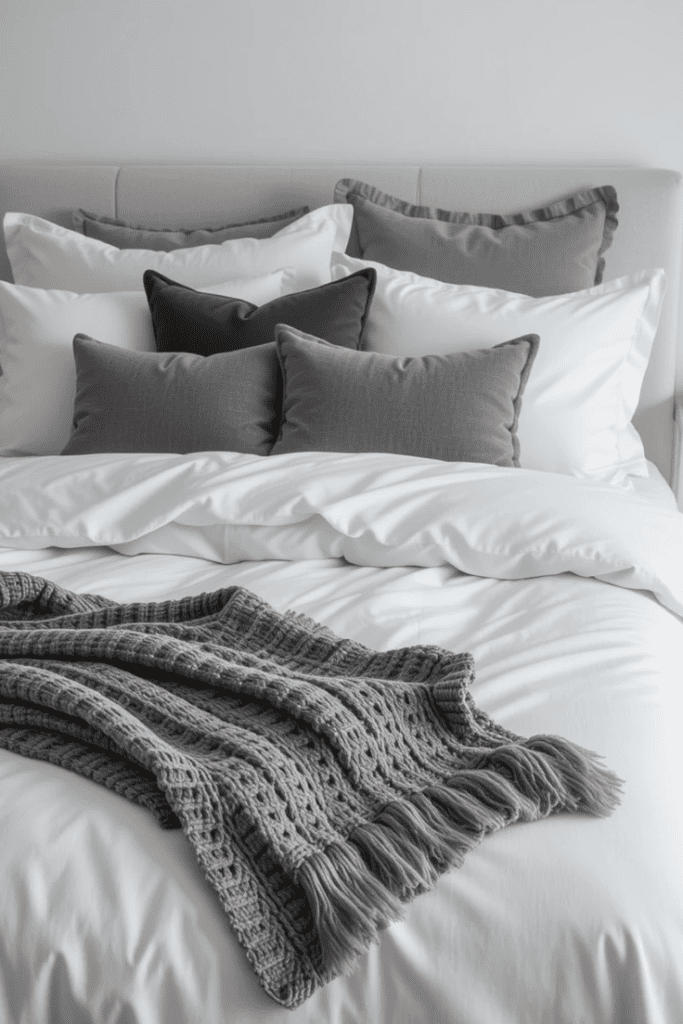
Begin with crisp white sheets as your foundation. Add a medium-tone gray duvet or quilt as your middle layer. Incorporate various textures through linen pillowcases, velvet accent pillows, and cotton shams to build visual interest and tactile comfort.
Pro tip: Place a chunky knit throw blanket across the foot of the bed to introduce additional texture without disturbing the color scheme.
2. Gray Accent Wall
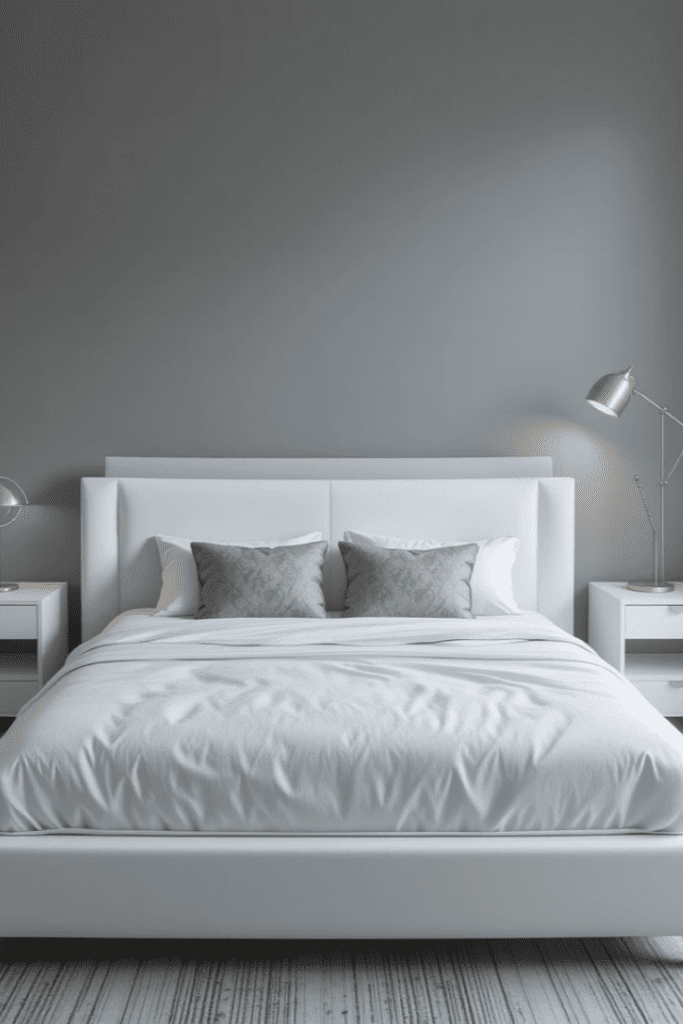
Transform one wall with a soft gray paint color to establish a focal point in the room. Complement this feature wall with white furniture pieces and bedding to emphasize clean lines and create purposeful contrast.
3. Textured Fabric Wall Panels
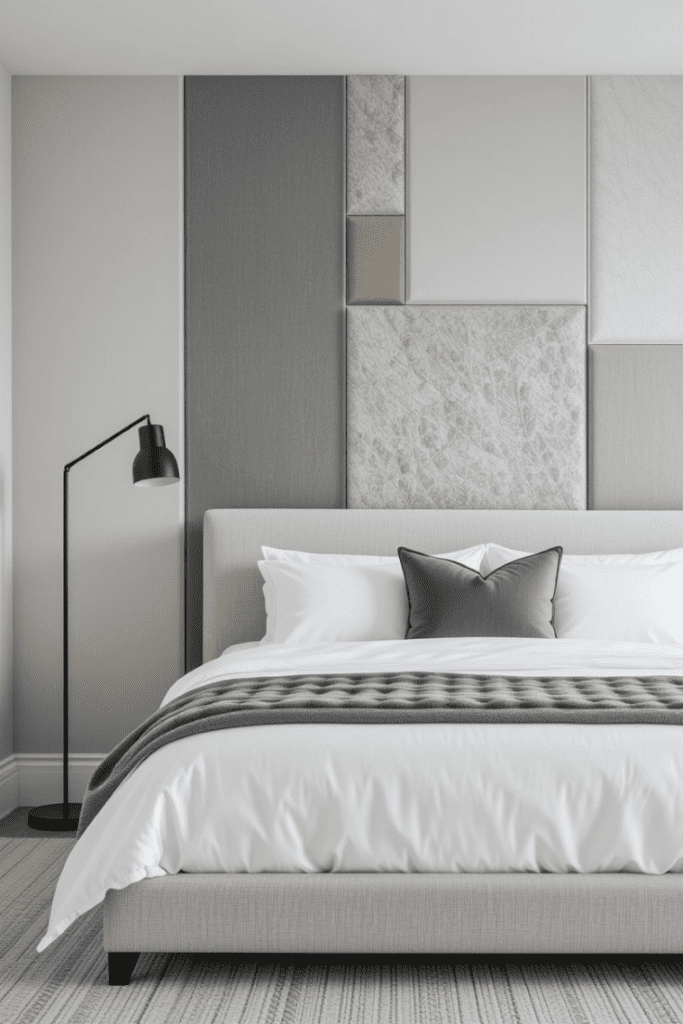
Mount upholstered panels in matte gray linen and creamy textured fabrics behind a streamlined white bed frame. Pair with pristine white bedding and a charcoal accent pillow to highlight textural elements. A black floor lamp can introduce modern contrast without disrupting the color palette.
4. Gray Upholstered Headboard
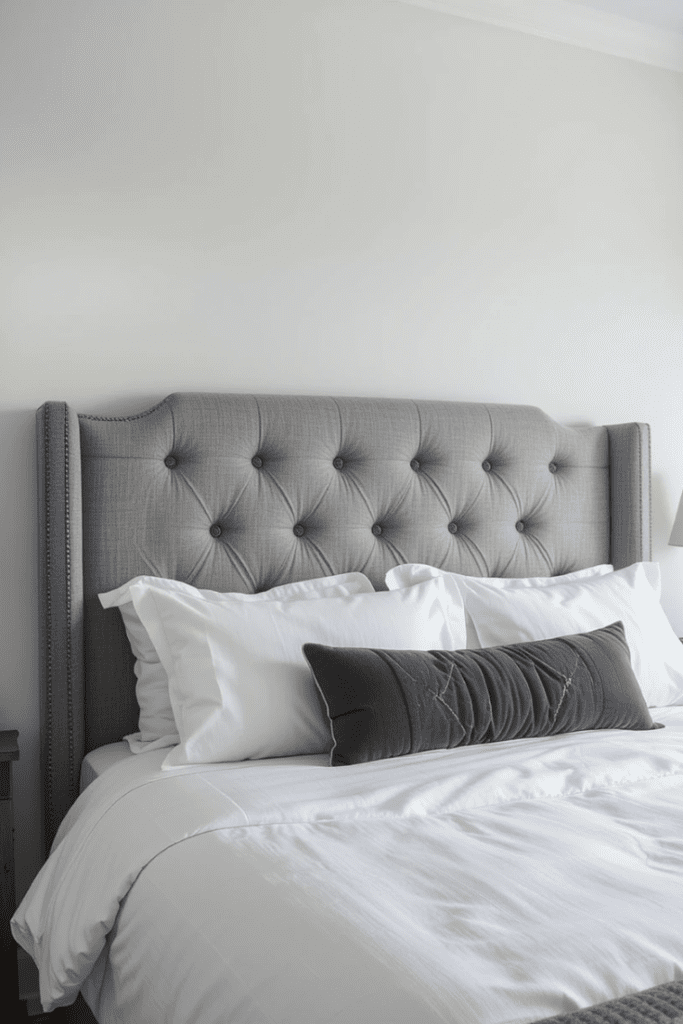
Select a tufted or nailhead-detailed headboard in gray fabric to serve as your bed’s centerpiece. This substantial element introduces texture while harmonizing beautifully with white bedding. For bedrooms with limited square footage, choose a design with a lower profile.
5. White and Gray Striped Bedding
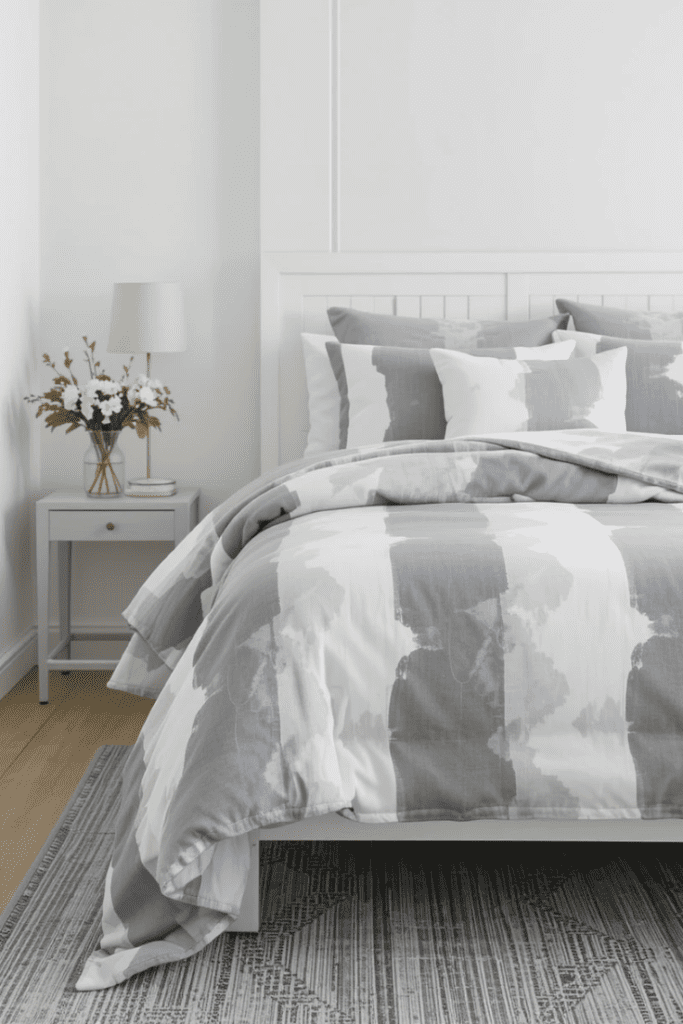
Incorporate horizontal or vertical stripes on duvet covers or pillowcases to add visual movement. Maintain neutral walls and furniture to allow these patterned elements to become a natural focal point.
6. Gray Area Rug
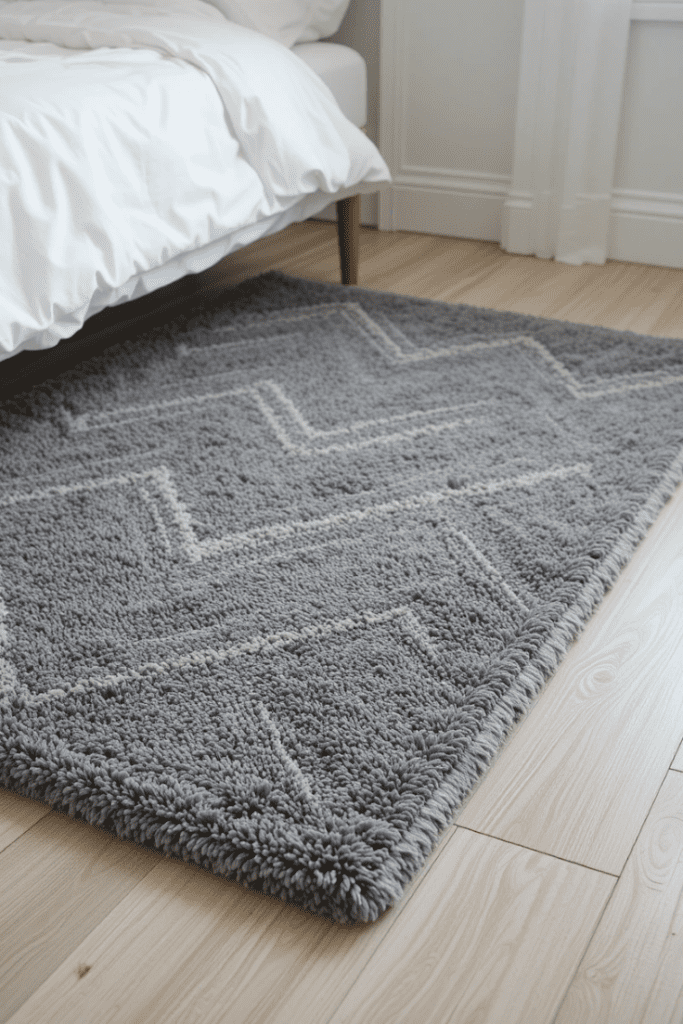
Position a luxurious gray floor covering beneath the bed. Subtle geometric patterns or textured solid options work particularly well. Ensure the rug extends at least 24 inches beyond the bed’s perimeter to create proper visual balance.
7. White Walls with Gray Furniture
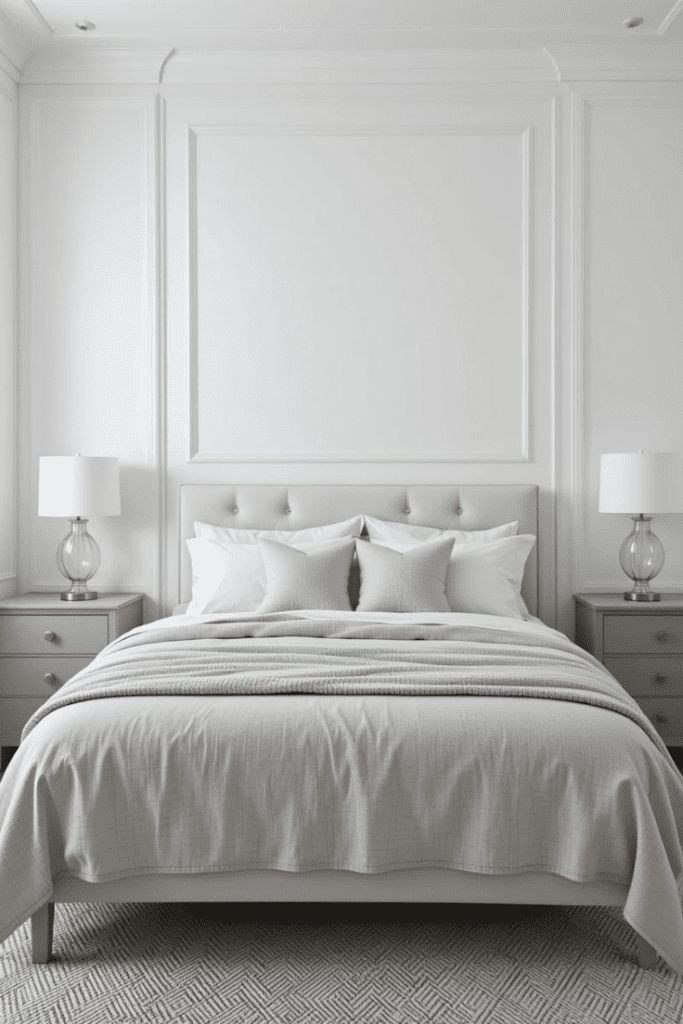
Maintain bright white wall surfaces and introduce gray through key furniture pieces such as dressers, nightstands, or accent seating. Choose matte finishes to minimize glare and add warmth to the space.
8. Geometric Patterns
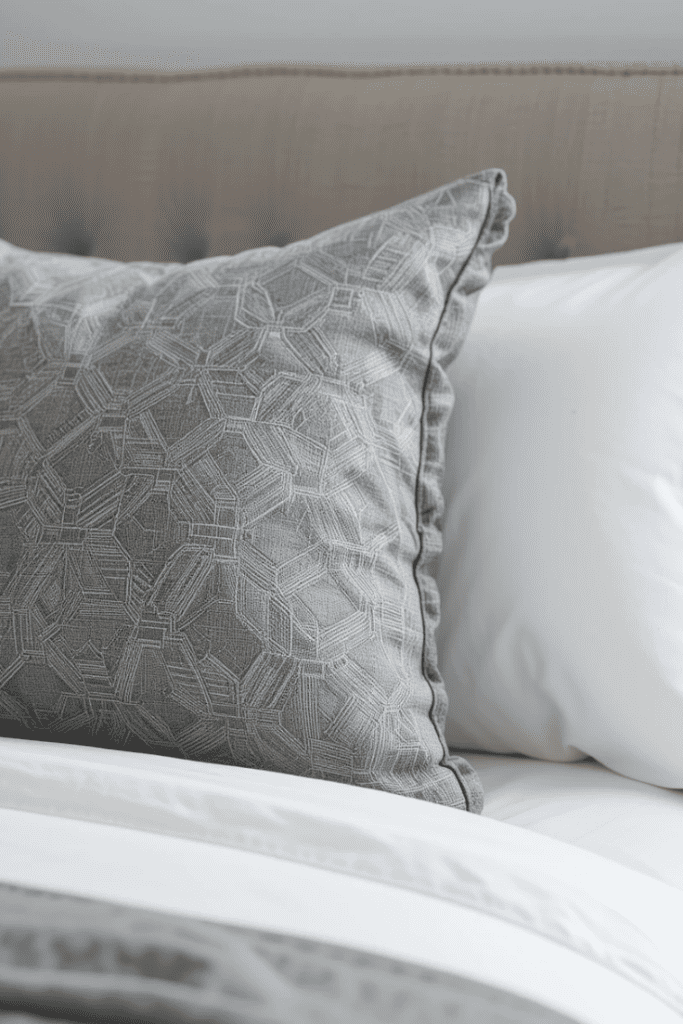
Integrate geometric designs thoughtfully through smaller accessories like throw pillows or area rugs. Select patterns with moderate contrast levels to maintain visual cohesion throughout the space.
9. Gray and White Ombre Curtains
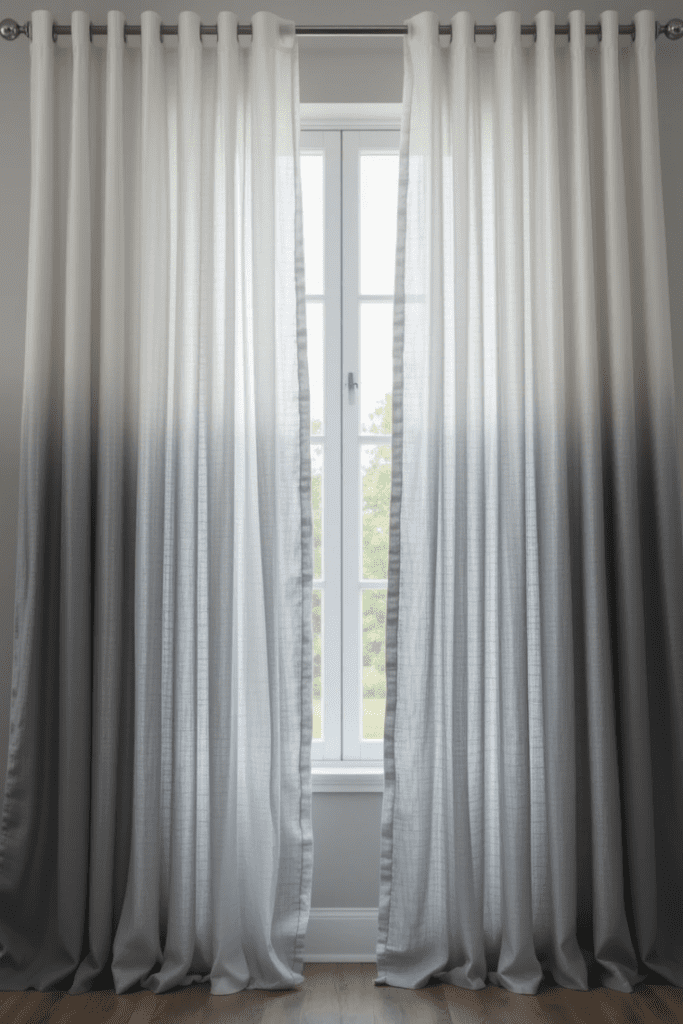
Install window treatments featuring a gentle gradient transitioning from white to gray. Sheer fabrics like linen diffuse natural light beautifully, while heavier drapery materials provide additional insulation and privacy.
10. Built-In White Shelving
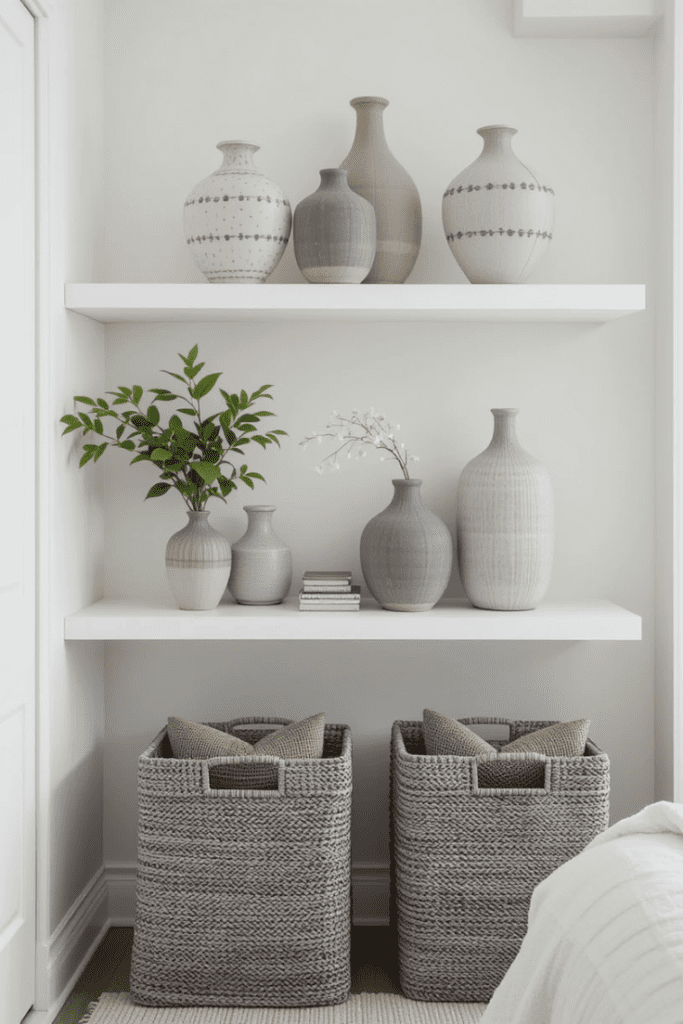
Mount floating shelves in white and style with gray decorative elements: ceramic vessels or hardcover books with neutral spines. Incorporate gray storage baskets for practical yet attractive organization.
11. Textured Throws and Pillows
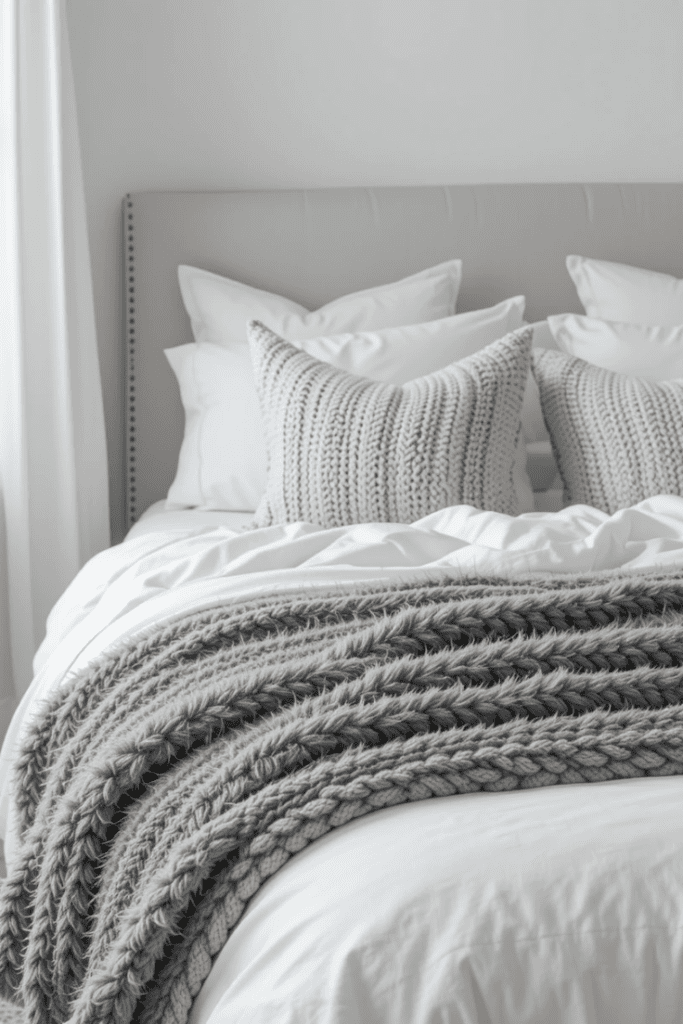
Layer multiple textile types—faux fur, cable-knit, or waffle-weave fabrics—in various gray shades. Limit yourself to 2–3 distinct textures to maintain visual clarity and prevent overwhelming the space.
12. White Bed Frame with Gray Accents
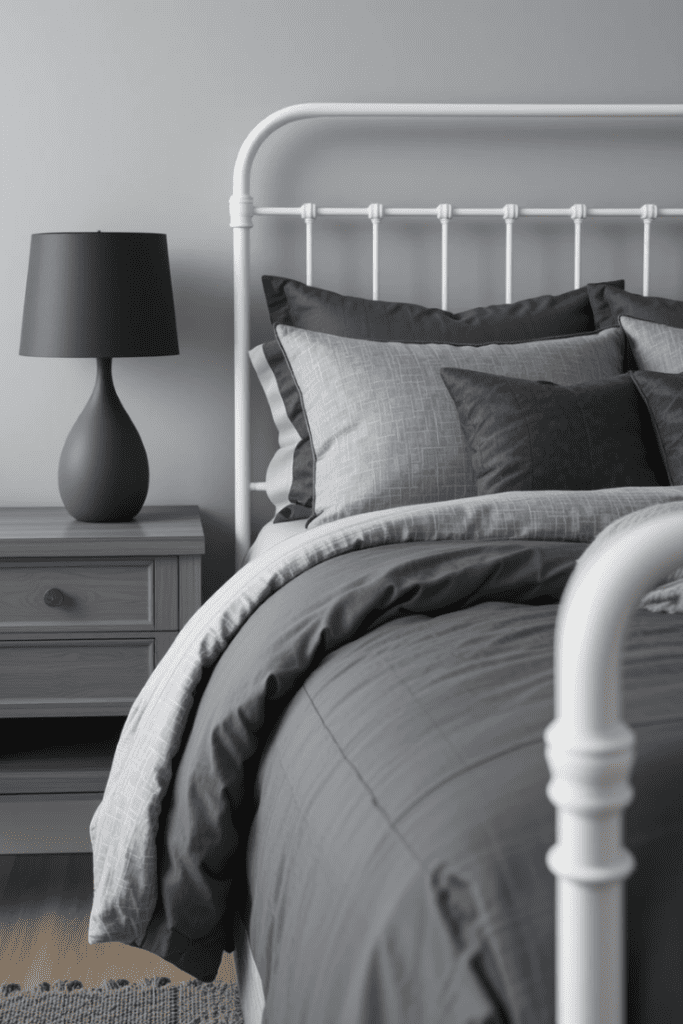
Select a white wooden or metal bed frame as your room’s anchor. Add gray bedding elements, such as a charcoal duvet cover or slate-colored decorative pillows, to create intentional contrast.
13. Subtle Gray Wallpaper
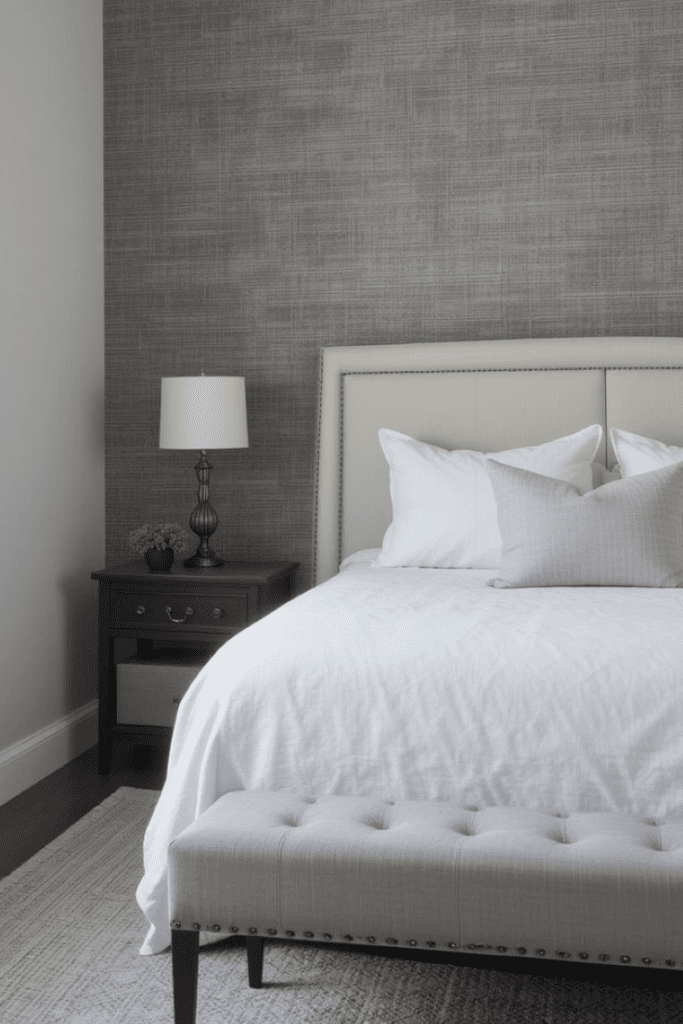
Apply textured gray wallpaper (such as grasscloth or concrete-effect) to a single wall. Combine with white trim elements for a balanced, designer-inspired finish.
14. Gray Walls with White Ceiling
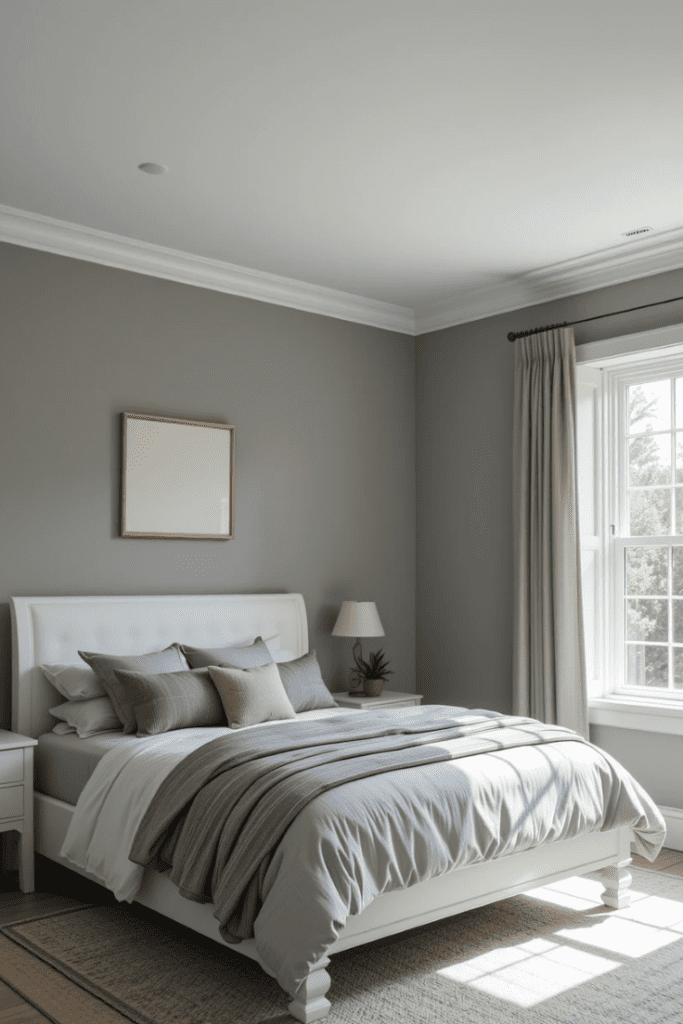
Paint wall surfaces in a warm gray tone while maintaining a white ceiling. This configuration creates a cozy yet spacious feeling, particularly in rooms with generous natural light.
15. Mixed-Tone Nightstands
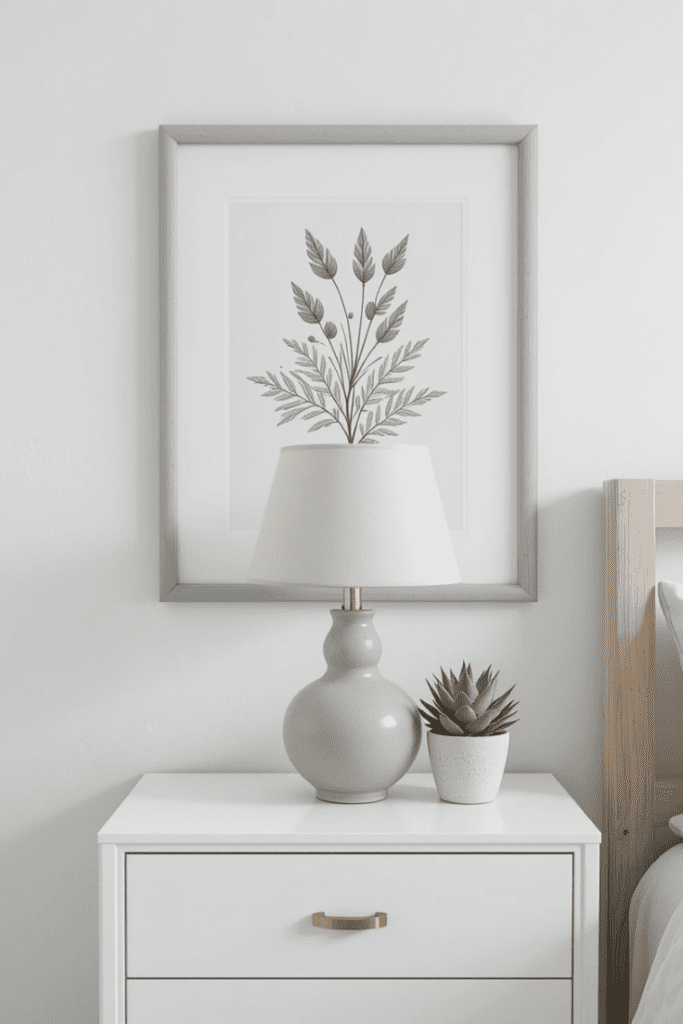
Create visual interest by pairing a white bedside table with a gray lamp, or reverse this combination. Add a small plant or metallic clock to unite these elements into a cohesive arrangement.
16. Matte-Glossy Contrast
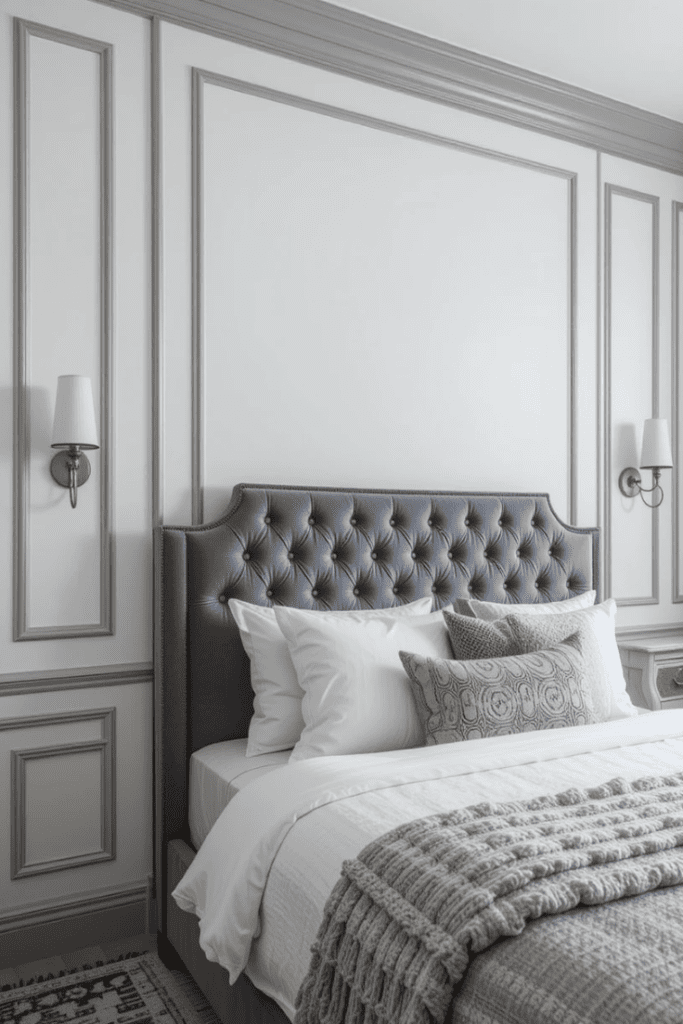
Apply matte white paint to walls while finishing trim in glossy gray for subtle textural variety. Complete the look with a gray velvet headboard and brushed nickel wall sconces to connect these different finish types.
17. Metallic Accents
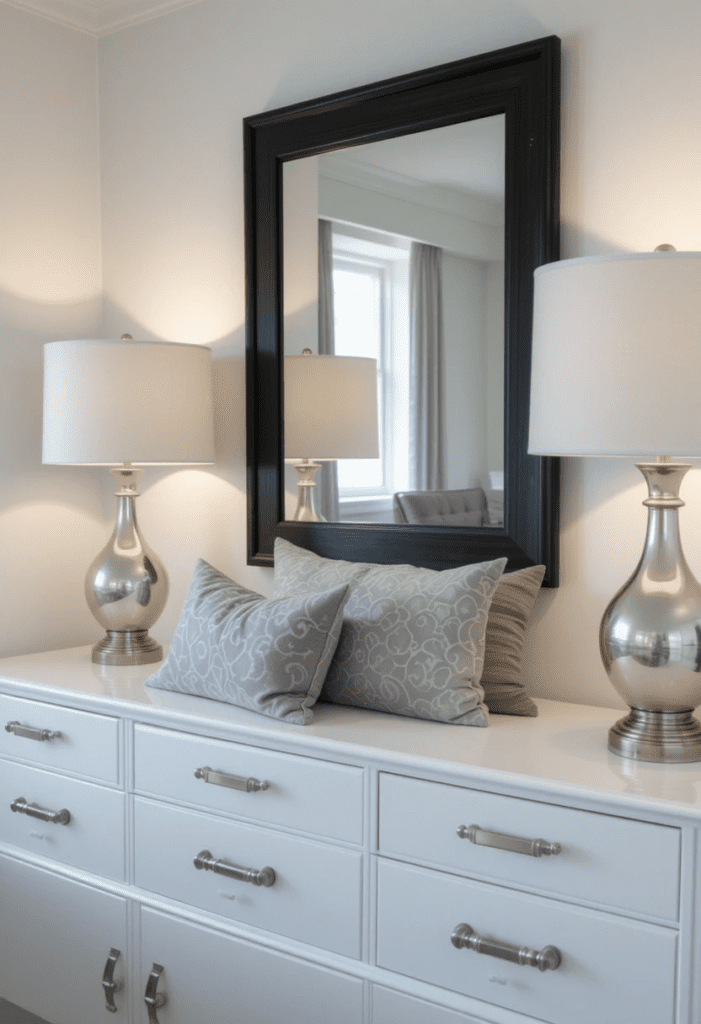
Incorporate silver, brushed nickel, or matte black finishes through lamps, drawer hardware, or decorative frames. These metallic elements prevent the neutral palette from appearing flat or uninspired.
18. Layered Curtains

Combine sheer white panels with substantive gray drapery. Install dual curtain rods to allow flexible control of natural light and privacy throughout the day.
19. Decorative Storage Solutions

Employ gray-and-white woven baskets, fabric containers, or ceramic organizers to manage everyday items. Select consistent shapes and styles to maintain a streamlined appearance.
20. Statement Lighting

Install an artistic pendant light or contemporary chandelier in white, black, or metallic finishes. Ensure the fixture’s proportions complement your room’s dimensions for maximum impact.
Essential Design Strategies for White and Gray Bedrooms
Layer Different Textures: Combine smooth, plush, and woven surfaces to create dimensional interest.
Incorporate Metallic Elements: Introduce silver, gold, or chrome accents for subtle luminosity.
Balance Light and Dark: Distribute white and gray elements evenly throughout the space for visual harmony.
Consider Temperature: Select warm grays for north-facing rooms and cooler grays for spaces with abundant sunlight.
Add Natural Elements: Incorporate wood tones or indoor plants to soften the monochromatic palette.
Questions & Answers About White and Gray Bedrooms
How can I prevent my white and gray bedroom from feeling cold or clinical?
Introduce natural materials like wooden furniture pieces, woven jute rugs, or rattan decorative elements. Install warm-spectrum lighting (bulbs rated 2700K–3000K) to create a welcoming atmosphere. Adding textural variety through fabrics and accessories also creates visual warmth without compromising your color scheme.
Is it acceptable to mix different gray shades in one room?
Absolutely, but maintain consistency by selecting 3–4 gray tones with similar undertones (either consistently warm or consistently cool). For example, pair warm greige wall color with other warm-leaning gray textiles for a cohesive look.
What flooring options work best with white and gray bedroom designs?
Light oak hardwood, whitewashed wood planks, or gray-toned carpeting complement this color scheme effectively. Avoid flooring with pronounced red or orange undertones, as these can clash with cooler gray elements in your design.
How do I select the most flattering gray paint color?
Always test paint samples in both natural daylight and your room’s artificial lighting. Generally, warm gray tones (those with beige or brown undertones) work well in north-facing rooms with cooler light. Cooler grays (with blue or purple undertones) often look best in sun-filled spaces.
Can black elements be incorporated into a white and gray bedroom?
Yes, when used judiciously. Black picture frames, lamp bases, or hardware details add definition and sophistication without overwhelming the palette. Limit black to approximately 10% of your overall design elements for best results.
What strategies work best for rooms with limited natural light?
Select warm gray tones rather than cooler shades, which can appear dreary in low light. Position mirrors strategically to maximize light reflection. Avoid dark charcoal on large wall surfaces, as this can make the space feel more confined.
How can I create a minimalist white and gray bedroom?
Focus on clean-lined furniture, concealed storage solutions, and perhaps one monochromatic art piece as a focal point. Limit decorative objects to just one or two statement items. Choose furniture with similar proportions and restrained details for visual consistency.
What are some budget-friendly ways to refresh my bedroom with this color scheme?
New bedding, gray decorative pillows, or painting a single accent wall offer high-impact changes at moderate cost. Creating simple DIY abstract art using black and white can also transform your space without significant investment.
How should I balance different textures in my white and gray bedroom?
Aim to include smooth surfaces (cotton, metal), textured elements (linen, jute), and soft components (velvet, faux fur). Limiting your selection to 3–4 distinct textures helps maintain visual harmony throughout the space.
Can I incorporate color accents in a white and gray bedroom?
Absolutely. Subtle color additions like blush pink, sage green, or navy blue can enhance your neutral foundation without overwhelming it. Keep colored elements to approximately 10-15% of your overall design for best results.
What lighting approaches work best for white and gray bedrooms?
Layer different light sources at various heights—overhead fixtures, wall sconces, and table lamps—to create depth. Choose warm-toned bulbs with metallic-finished fixtures for a welcoming ambient glow.
How can I make my white and gray bedroom feel more comfortable and inviting?
Layer multiple soft textiles like throws, pillows, and area rugs. Incorporate warm lighting with dimmer controls. Add curved forms to balance the often straight lines of contemporary furniture.
What’s the most effective way to arrange furniture in a white and gray bedroom?
Position the bed as your primary focal point, typically on the wall opposite the entrance. Arrange other furniture pieces to create balanced flow and functionality. In smaller spaces, keep nightstands proportional to the bed size and consider wall-mounted lighting to free up surface area.
How can I incorporate plants into my white and gray bedroom design?
Select varieties suited to your room’s light conditions and place them on nightstands, shelves, or in hanging planters. Low-maintenance options like succulents, snake plants, or pothos varieties thrive in bedroom environments while adding natural texture and subtle color.
